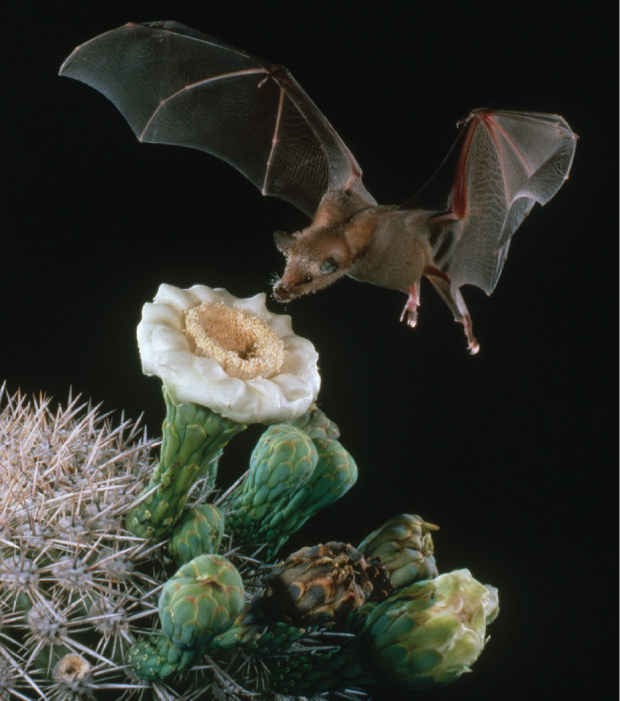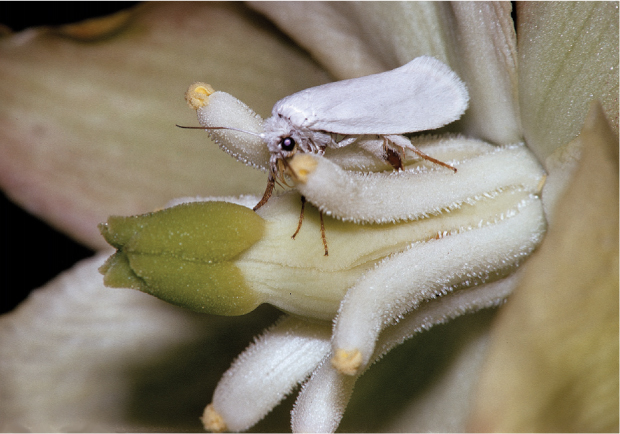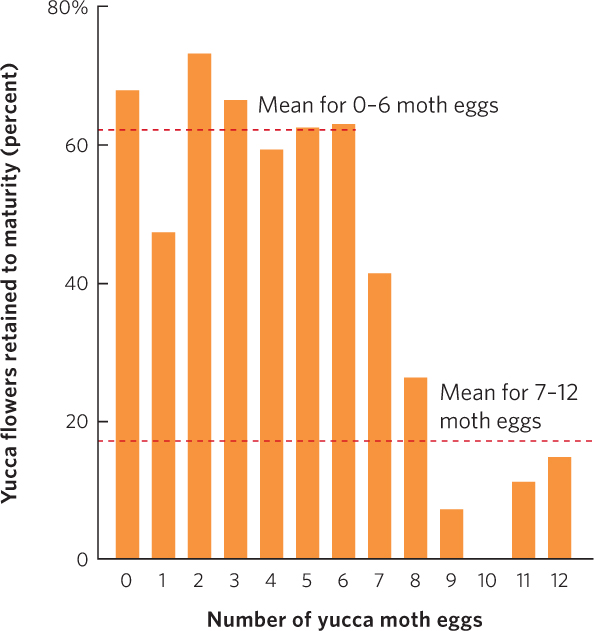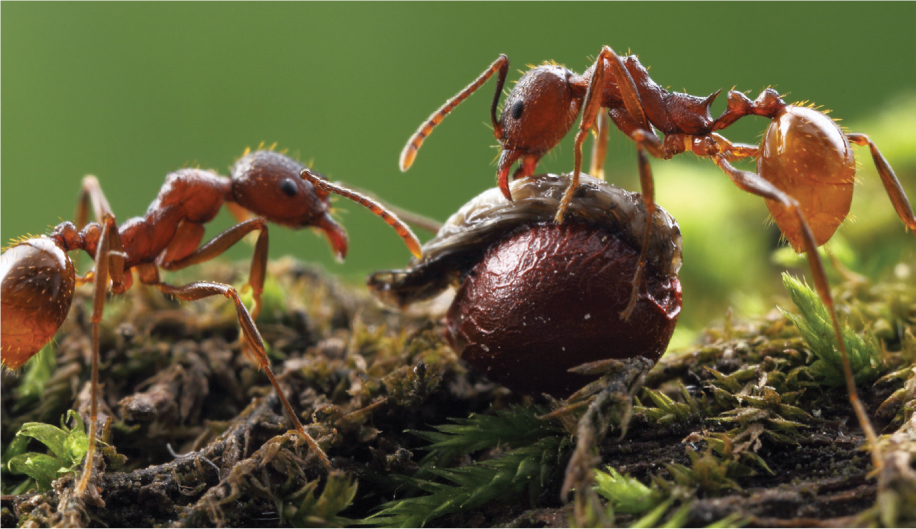Mutualisms can facilitate pollination and seed dispersal
In addition to providing resources and defense, mutualisms can also provide the valuable services of plant pollination and the dispersal of plant seeds. Indeed, without these services many species could not reproduce or colonize areas throughout their geographic range. In this section, we will examine the various mutualisms that serve these functions.
Pollination
To make seeds, flowering plants need pollen to fertilize their ovules. Some plants, such as grasses, commonly rely on the wind to blow pollen from one plant to another. Other plants rely on animals to carry the pollen. Over evolutionary time, plants have evolved a number of reward mechanisms to entice pollinators to visit their flowers. For example, the common honeybee visits flowers that offer both nectar and pollen. The bees consume both items, but the bees also inadvertently transfer some of the pollen that is attached to their bodies as they move from flower to flower. Many plants appear to have evolved flowers that are specialized in attracting one particular type of pollinator. For example, flowers pollinated by hummingbirds tend to be red—a color hummingbirds favor. Plants pollinated by hummingbirds also tend to possess long tubular flowers inaccessible to most insects. However, because hummingbirds have long tongues, they can easily reach the nectar inside. Similarly, many batpollinated flowers are large, are often open only at night, and contain high volumes of nectar to attract the large pollinators. In some plant species, the volume of nectar increases during the night when bats are most likely to be foraging (Figure 17.13).

Although flowers in many species of plants can be pollinated by several different pollinator species, some plants, such as the group known as yuccas, have evolved very specific mutualisms with their pollinators. In fact, most species of yucca plants rely on a single species of yucca moth for pollination. Unlike most pollinators, however, a visit from the yucca moth is not a brief affair. A female yucca moth arrives at a yucca flower and lays eggs in the ovaries of the flower (Figure 17.14). To ensure that the flower makes seeds for her offspring to eat, the female moth climbs to the top of the flower and adds pollen to the flower’s stigma. This pollen produces a long tube that grows down through the style and into the ovary where it deposits the male gametes, which then fuse with the female gametes to produce seeds. The moth eggs hatch into caterpillars that feed on the seeds that the flower forms. As a result, the plant gains a very effective pollinator at the cost of a few seeds.

Despite the consumption of seeds by the caterpillars, enough seeds remain for the yucca to reproduce. For many years researchers wondered what prevented the female moths from laying so many eggs that all the seeds would be consumed, leaving the flower with no fitness. After careful observation, they discovered that the plant is tolerant of up to six moth eggs per flower. Under these conditions, the plant develops 62 percent of its flowers to maturity. However, if there are more than six eggs per flower, some species of yuccas selectively abort most of their flowers and retain only 17 percent of their flowers to maturity, as shown in Figure 17.15. When a flower is aborted, all moth eggs and larvae within the aborted flower dies. By aborting flowers whenever the moths lay more than six eggs, the plant favors those moths that do not lay too many eggs in each flower.

401
Seed Dispersal
The seeds and fruits produced by plants span a wide range of sizes, from tiny dandelion seeds that float on the wind to massive fruits such as coconuts. Many of the smallest seeds are easily dispersed by wind, but larger seeds are typically dispersed by animal mutualists. As we have seen, animals act in this role if they receive a benefit in return. The most common benefit is food in the form of seeds or nutritious fruit that surrounds the seeds. When animals eat the fruits of plants, the seeds commonly pass through the digestive system unharmed and are viable after being excreted. However, when animals eat the seeds of plants, the seeds are digested and are no longer viable.
It may seem like a contradiction that plants would depend on seed-eating animals to help disperse their seeds. After all, if the seeds are eaten, there are no seeds left to disperse. However, in most cases, plants produce large numbers of seeds and not all seeds that are carried away get eaten. Many of them are stored in the ground, which means that the seeds are planted and able to germinate if they are not consumed. For example, squirrels store acorns in numerous locations and some of these acorns are never retrieved. Similarly, a single Clark’s nutcracker (Nucifraga columbiana)—a bird that specializes on the seeds of the whitebark pine (Pinus albicaulis)—collects approximately 32,000 pine seeds in a season and stores them in thousands of different locations. Because this number of seeds is three to five times what the bird requires to meet its energy needs, many of the stored seeds are never eaten but rather germinate into new pine trees in locations far from the parent tree.
Some species of plants entice animals to disperse their seeds by surrounding them with a fruit that contains substantial nutrients. For example, many forest herbs including the painted trillium (Trillium undulatum) produce seeds that have a lipid- and protein-rich package—known as an elaiosome— attached to the seed (Figure 17.16). Ants collect the seeds and take them back to their nests. After consuming the elaiosomes, they discard the seeds from the nest. This process disperses the seeds away from the parent plant. The ants receive nutrition and the plants receive dispersal of their seeds.

402
When plants surround their seeds with a large fruit, the fruit can serve as a substantial reward to animal dispersers. If the seeds inside the consumed fruit have a hard coat that resists digestion, they pass through the animal’s digestive system and are still able to germinate. One of the most striking examples is the African tree known as Omphalocarpum procerum. The tree produces fruits as large as a person’s head and only the African elephant can break it open. Moreover, the seeds cannot germinate in the soil unless they have passed through an elephant’s digestive system. The tree is highly dependent on elephants to consume and disperse its seeds, but, as elephant populations decline, the tree is losing its seed disperser.
A key element to this strategy for seed dispersal is to remain inedible or hidden until the seeds are fully developed. As a result, many fruits are green and relatively camouflaged while the seeds are developing. At this stage, the fruit is typically quite unpalatable. However, once the seeds have fully developed, the fruit becomes ripe, the tissues of the fruit become palatable, and it commonly changes color to be highly visible to animal dispersers.